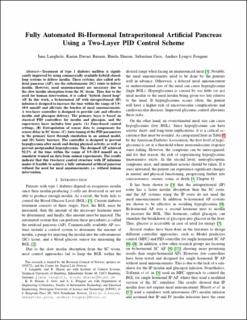| dc.contributor.author | Langholz, Jana | |
| dc.contributor.author | Davari Benam, Karim | |
| dc.contributor.author | Sharan, Bindu | |
| dc.contributor.author | Gros, Sebastien Nicolas | |
| dc.contributor.author | Fougner, Anders Lyngvi | |
| dc.date.accessioned | 2023-08-15T10:51:25Z | |
| dc.date.available | 2023-08-15T10:51:25Z | |
| dc.date.created | 2023-06-16T12:04:51Z | |
| dc.date.issued | 2023 | |
| dc.identifier.isbn | 978-3-907144-09-1 | |
| dc.identifier.uri | https://hdl.handle.net/11250/3084121 | |
| dc.description.abstract | Treatment of type 1 diabetes mellitus is significantly improved by using commercially available hybrid closed-loop systems to deliver insulin. These systems, also called artificial pancreas (AP), use the subcutaneous (SC) route to deliver insulin. However, meal announcements are necessary due to the slow insulin absorption from the SC tissue. Thus due to the need for human intervention, it is called “hybrid closed loop” AP. In this work, a bi-hormonal AP with intraperitoneal (IP) infusion is designed to increase the time within the range of 3.9–10.0 mmol/l and alleviate the burden of meal announcements. A two-layer controller is designed to provide safe and effective insulin and glucagon delivery. The primary layer is based on classical PID controllers for insulin and glucagon, and the supervisory layer includes four parts: (A) Zone-based control settings, (B) Extrapolation of sensor data to compensate for sensor delay in SC tissue, (C) Auto-tuning of the PID parameters in the primary layer through simulation in an animal model, and (D) Safety barriers. The controller is designed to prevent hypoglycemia after meals and during physical activity, as well as prevent postprandial hyperglycemia. The designed AP achieved 92.5% of the time within the range of 3.9–10.0 mmol/l on a simulator trained on data from animal experiments. The results indicate that this two-layer control structure with IP infusions makes it feasible to achieve a fully automated artificial pancreas without the need for meal announcements, i.e. without human intervention. | en_US |
| dc.language.iso | eng | en_US |
| dc.publisher | Institute of Electrical and Electronics Engineers (IEEE) | en_US |
| dc.relation.ispartof | Proceedings of the 2023 European Control Conference (ECC) | |
| dc.rights | Navngivelse 4.0 Internasjonal | * |
| dc.rights.uri | http://creativecommons.org/licenses/by/4.0/deed.no | * |
| dc.subject | Type 1 diabetes | en_US |
| dc.subject | Type 1 diabetes | en_US |
| dc.subject | Automatisk glukoseregulering | en_US |
| dc.subject | Closed loop glucose control | en_US |
| dc.subject | Intraperitoneal insulininfusjon | en_US |
| dc.subject | Intraperitoneal insulin infusion | en_US |
| dc.subject | Kunstig bukspyttkjertel | en_US |
| dc.subject | Artificial Pancreas | en_US |
| dc.title | Fully Automated Bi-Hormonal Intraperitoneal Artificial Pancreas Using a Two-Layer PID Control Scheme | en_US |
| dc.title.alternative | Fully Automated Bi-Hormonal Intraperitoneal Artificial Pancreas Using a Two-Layer PID Control Scheme | en_US |
| dc.type | Chapter | en_US |
| dc.description.version | acceptedVersion | en_US |
| dc.subject.nsi | VDP::Medisinsk teknologi: 620 | en_US |
| dc.subject.nsi | VDP::Medical technology: 620 | en_US |
| dc.source.pagenumber | 186-193 | en_US |
| dc.identifier.doi | 10.23919/ECC57647.2023.10178295 | |
| dc.identifier.cristin | 2155243 | |
| dc.relation.project | Norges forskningsråd: 248872 | en_US |
| cristin.ispublished | true | |
| cristin.fulltext | postprint | |

